You might not have heard much about glyphosate, let alone knew that you were drinking it in your water.
If you have heard of glyphosate recently, it’s likely because the dangers of this chemical are only now becoming better-known.
In this guide, I’ll be discussing what glyphosate is, its health effects, and how to remove it from your water. I’ll also be answering your frequently asked questions relating to glyphosate.
Table of Contents
💡 What is Glyphosate (Roundup)?
Glyphosate is the main ingredient in a herbicide called Roundup, and is also present in nearly 100 other herbicides available to buy today. Its effectiveness as a herbicide was discovered in the early 1970s, and it is currently used predominantly as a weed-killer.
Roundup is used to kill broad-leafed grasses and weeds. It’s a systemic herbicide, which means that it is absorbed by foliage, before being transported to the plant’s growing points, where it inhibits an enzyme that is responsible for synthesis.
Glyphosate herbicide products are used widely in the agricultural industry. In fact, Roundup is the most commonly-used herbicide in the US. Glyphosate is also included in a number of domestic gardening products.

🚱 How Does Glyphosate Get Into Water?
Surface runoff and poor agricultural practices are the two biggest causes of glyphosate in drinking water.
Rainwater can wash herbicides containing glyphosate into ditches, streams and lakes. Glyphosate may also seep into the ground and get into groundwater sources.
Whether you have a private well above or below the ground, or you get your water from a municipal supplier, there’s a chance that your water contains glyphosate – especially if you live in an area with elevated agricultural activity.
Your municipal water supplier might remove glyphosate from your water supply, but this isn’t guaranteed. If you own a private well, your risk of excessive glyphosate exposure is even greater.
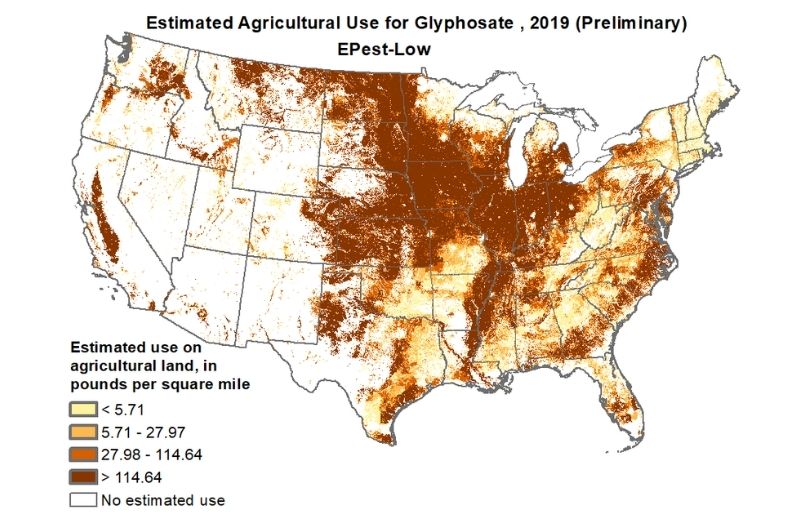
🩺 Health Risks Associated With Glyphosate
The Environmental Protection Agency (EPA) advises a Maximum Contaminant Level of 700 ug/L for glyphosate in the US. At the time that this MCL was put in place, it was assumed that glyphosate wasn’t bio-accumulative (or that it couldn’t build up in our bodies over the years), but emerging evidence suggests that this may be false.
According to science.org, the International Agency for Research on Cancer (IARC) now says that glyphosate “probably” causes cancer.
Some of the potential risks of glyphosate exposure are as follows:
Probably Carcinogenic to Humans
Even today, research on cancer and glyphosate is limited. We can’t be certain that increased levels of glyphosate are cancer-causing, but we know enough to determine that they probably are.
One study by the University of Washington found that exposure to the widely used herbicide Roundup may increase risk of cancer by more than 40%. This is certainly worrying information, as glyphosate is an active ingredient in Roundup.
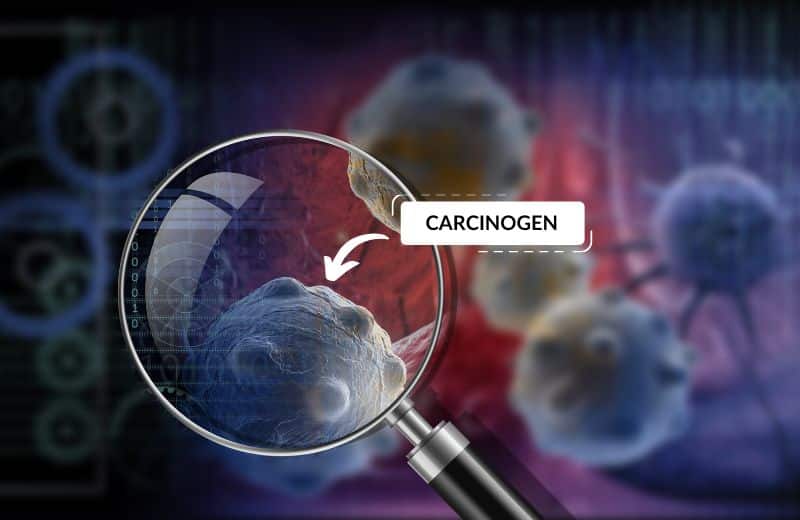
Toxicity
Toxicity from low levels of glyphosate is unlikely, but one study found that exposure to elevated concentrations of glyphosate can cause death.
Luckily, it’s unlikely that your private well will become contaminated with elevated concentrations of glyphosate, but it’s concerning to know that this chemical is now considered to be bio-accumulative, and may build up to toxic levels in our bodies over time.
Other Health Effects
A report found that glyphosate has been liked to a host of other worrying health effects, including leaky-gut syndrome, autism, endocrine disruption, and celiac disease.
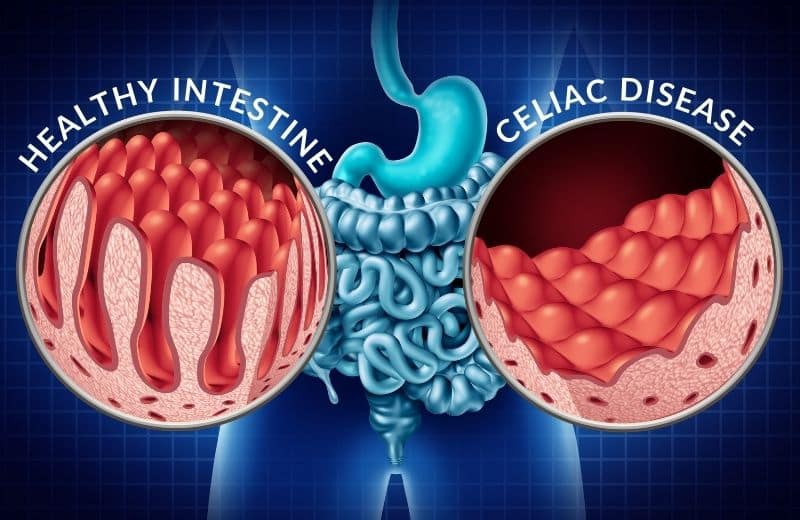
The overall health risk of glyphosate is still uncertain, but it’s clear that this chemical isn’t fit for human consumption.
🧪 How to Test for Glyphosate in Drinking Water
First off, if you don’t actually know whether your drinking water contains glyphosate or not, I recommend testing for this contaminant.
You’ll struggle to find at-home testing kits for glyphosate. Instead, for clear, accurate results, I recommend paying for certified laboratory testing.
Certified Laboratory Testing
Certified laboratory testing involves taking a sample of your water and sending it off to a state-certified lab. You’ll receive your test results after several days, letting you know exactly how much glyphosate your water contains.
Not all laboratories test for glyphosate. I recommend TapScore by Simple Lab, which offers a glyphosate water test for just over $100. This EPA testing method has a 12-day turnaround and offers a detailed, qualified analysis of glyphosate.

✔️ How to Remove Glyphosate from Drinking Water
It’s highly unlikely that you’ll have the power to prevent glyphosate and other pesticides and herbicides from getting into your water in the first place. It’s not always easy to determine the exact source of contamination, which can make it difficult to put a stop to it altogether.
Instead, you should focus on removing glyphosate from your drinking water supply before it can be used for drinking. There are several water filters that offer removal of glyphosate: reverse osmosis, distillation, nanofiltration, and activated carbon filters.
Reverse Osmosis
RO water filters send water through a series of filtration stages, including a carbon water filter, a sediment pre-filter, and a semi-permeable membrane.
The semi-permeable membrane is what makes RO purification unique from anything else. This membrane traps the majority of total dissolved solids (TDS) in drinking water, acting as a barrier and allowing only small water particles to pass through.
Because water is forced through the filter at a high pressure, any contaminants that are too large to fit through the membrane – like glyphosate – bounce back into the RO chamber, where they’re flushed away with wastewater.
RO water filters can remove a broad range of drinking water contaminants, such as heavy metals, chemicals, dissolved minerals, and microbiological impurities.
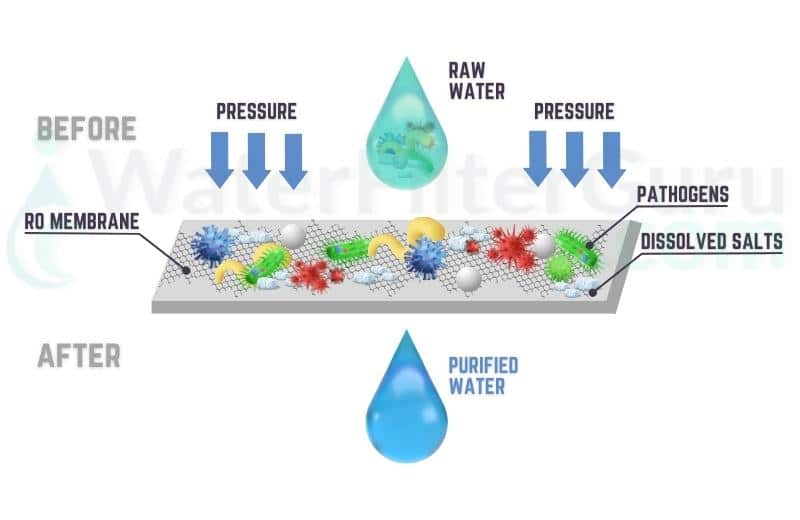
Note that RO systems aren’t the most efficient water treatment solutions, because they waste some water during the filtration process. They’re also one of the more expensive options, because of their ability to greatly improve water quality. An under-sink RO filter, offering purification of tap water, can set you back up to $500. Most manufacturers will offer free shipping though, which is a bonus.
You’ll need to replace filters in an RO system every 6 – 12 months, and the semi-permeable membrane typically needs replacing after 2 years.
Distillation
Water distillers offer another highly effective means of removing almost all contaminants from drinking water.
In the distillation process, water is boiled until it evaporates. It then travels down a cooling corridor and condenses into a separate container. Contaminants with higher boiling and evaporation points than water (i.e. most of them) are left behind in the boiling chamber, and can be washed away when you clean the system between uses.
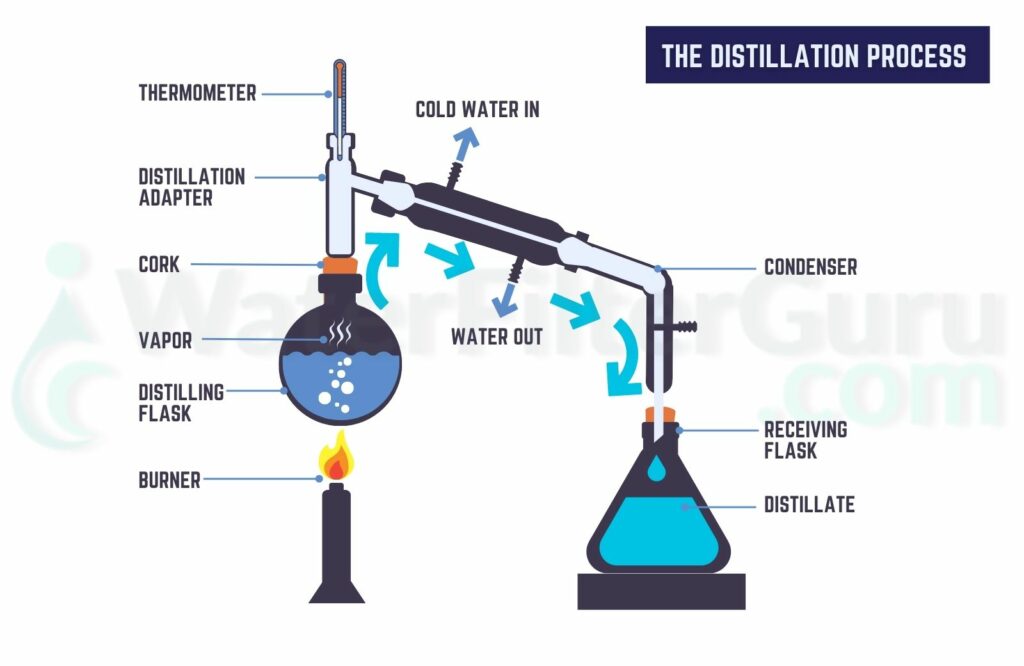
Distillation doesn’t remove every single contaminant with boiling and condensing. For this reason, these systems typically include a small filter at the spout, which can remove anything that distillation may have missed.
Some of the contaminants that distillation can remove are chlorine, lead, nitrate, bacteria, most pesticide chemicals, and water hardness.
A distillation system costs around $100-$300. With only one small filter to change, distillers are very cost-effective in the long run – they’re almost free to operate, in fact. They require very little maintenance, aside from cleaning out the boiling chamber to prevent a build-up of contaminants.
Nanofiltration
Nanofiltration is a process similar to RO purification, though not quite as capable. A nanofiltration water filter uses a membrane that has a pore size of 0.001 microns.
Water is forced against this membrane, and certain contaminants, such as bacteria, viruses, protozoa, organic matter, salt, natural minerals, pesticides and herbicides, are unable to pass through.
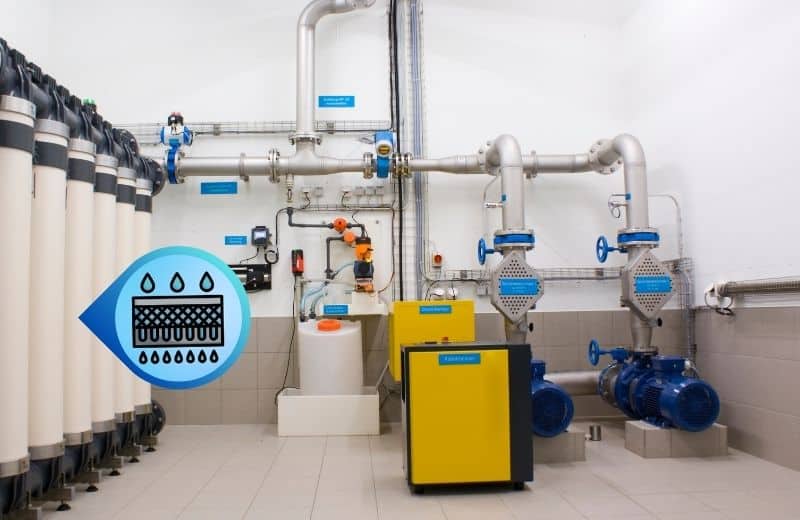
Nanofilters are primarily used to soften and disinfect drinking water, but they’re also capable of removing herbicides like glyphosate. They don’t offer complete purification of water.
Though nanofiltration systems are available for at-home applications, they’re not as popular as the other water filter systems on this list. Most nanofilter units are expensive, too, costing more than $1,000 per unit.
Activated Carbon Filters
Activated carbon filters use a process known as adsorption to grab onto impurities when water flows through their media. They have a wide surface area and thousands of tiny pores, which are too small to allow many contaminants to pass through.
You can get carbon filters in a variety of filter models, like countertop gravity filters and drinking water pitchers. Both the Big Berkey Countertop Filter and the Clearly Filtered pitcher can remove 99.9% glyphosate from tap water.
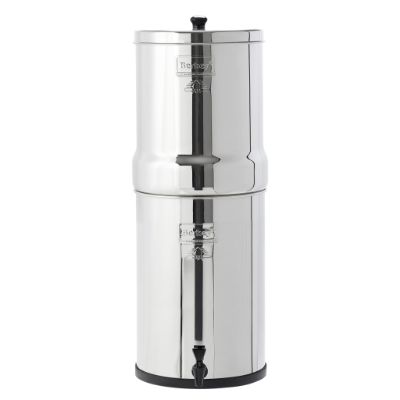
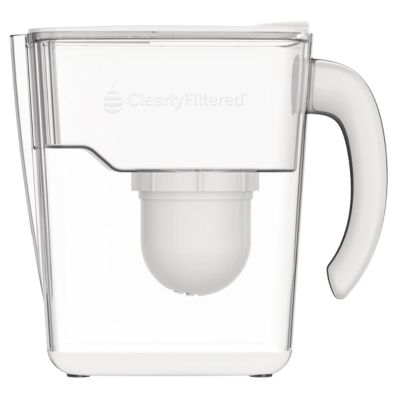
These water filters can remove a host of other common tap water contaminants, such as chlorine, pesticides and herbicides, and heavy metals like lead.
Because carbon filters are so widely available and low-cost to make, they’re one of the best affordable options for tap water treatment available. You can get a complete pitcher filter, with an initial water filter, for less than $20.
You’ll need to replace this water filter every 3-6 months, depending on the design of the filter, your filtration requirements, and your water quality.
❔ Roundup/ Glyphosate Removal FAQ
Does boiling water remove glyphosate?
No. Boiling water won’t remove glyphosate or any other pesticides or herbicides. Glyphosate has a high melting and decomposition point – much higher than water’s boiling point. This means that when you boil water, you’ll just end up evaporating some of the water and concentrating the glyphosate.
Does glyphosate eventually disappear on its own?
Yes, but after a very long time. When glyphosate is released into the environment, it can last for up to 170 days in low-light conditions, or up to 300 days in dim conditions, such as in an underground groundwater source. So if glyphosate makes it into public water sources, it can end up staying there for months. This makes it likely that humans will be exposed to this herbicide.
Aside from filtering my water, how else can I reduce my glyphosate exposure?
Glyphosate is sprayed onto crops, which means that it can end up in our food. You’re potentially eating food containing glyphosate if it isn’t organic. The best way to avoid glyphosate exposure is to choose organic, high-quality crops that won’t have been sprayed with chemical products during growth. Organic soil is also a lot higher in minerals, which is an advantage to both you and the environment.
If you can’t afford to eat organic, try to eat locally-grown produce as much as possible, which is far less likely to have been doused in glyphosate.
